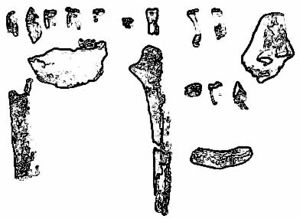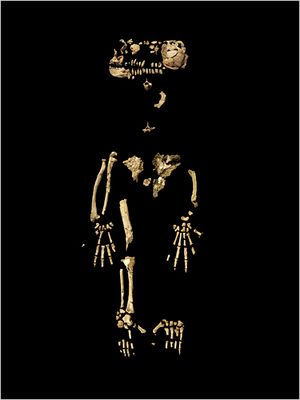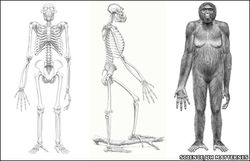أرضيپيثكس
أرضيپيثـِكـَس Ardipithecus هو جنس أشباه البشر Hominini (تحت فصيلة الإنسانيات Homininae) مبكر جداً عاش قبل 4.4 مليون سنة[1] during the early Pliocene.
| أرضيپيثـِكـَس Ardipithecus Temporal range: Pliocene
| |
|---|---|

| |
| أحفورات أرضيپيثكس كدبـّة | |
| التصنيف العلمي | |
| مملكة: | |
| Phylum: | |
| Class: | |
| Order: | |
| Family: | |
| Subfamily: | |
| Tribe: | |
| Genus: | أرضيپيثكس هوايت وزملاؤه، 1995
|
| الأنواع | |

لأن هذا النوع يتشارك في عدة سلوكيات مع أجناس القردة العليا الأفريقية (جنس پان وجنس الغوريلا)، يعتبره البعض في جانب الشيمپانزي بدلاً من الفرع البشري، إلا أن الأغلبية تعتبره الإنسان الأولي بسبب تشابه الأسنان مع أسترالوپيثكس.[بحاجة لمصدر]
أنظر| "أرضي" تبطل نظرية داروين
. . . . . . . . . . . . . . . . . . . . . . . . . . . . . . . . . . . . . . . . . . . . . . . . . . . . . . . . . . . . . . . . . . . . . . . . . . . . . . . . . . . . . . . . . . . . . . . . . . . . . . . . . . . . . . . . . . . . . . . . . . . . . . . . . . . . . . . . . . . . . . . . . . . . . . . . . . . . . . . . . . . . . . . .
النوع
تم توصيف نوعين، أرضيپيثكس رميدوس و أرضيپيثكس كدبـّة. أ. كدبـّة وُصف في البداية كتحت جنس أ. رميدوس، ولكن بناءً على الأسنان المكتشفة مؤخراً في إثيوپيا فقد تم ترقيتها إلى توصيف "نوع". وقد تم العثور على بقايا من النوعين في أواش الوسطى.
أرضيپيثكس رميدوس
أ. رميدوس was named in September 1994. The first fossil find was dated to 4.4 million years ago based on its interval between two volcanic strata: the basal Gaala Tuff Complex (GATC) and the Daam Aatu Basaltic Tuff (DABT). Subsequent fossil discoveries by Yohannes Haile-Selassie and Giday WoldeGabriel — if identified as A. ramidus — would push the date back as far as 5.8 million years ago.[2]
"أرضي"
On 1 October 2009, after fifteen years of study,[3] paleontologists announced the detailed analysis of an A. ramidus fossil skeleton, deeming it the oldest fossil skeleton of a human ancestor. The fossil is the remains of a small-brained, 50 kg (110 lb) female nicknamed "Ardi". It was discovered in Ethiopia's harsh Afar desert at a site called Aramis in the Middle Awash region. Radiometric dating of the layers of volcanic ash encasing the deposits revealed that Ardi lived 4.4 million years ago. The fossil revealed that human ancestors underwent a previously poorly-known stage of evolution more than a million years before Lucy (Australopithecus afarensis), the iconic early human ancestor who lived 3.2 million years ago, and which was discovered in 1974 just 74 km (46 mi) away from Ardi's discovery site. Researchers speculate that the form of her pelvis and limbs suggest that she was a biped when moving on the ground but a quadruped when moving about in tree branches.[4][5]
أرضيپيثكس كدبـّة
Some sources assert that A. kadabba is dated to have lived between 5.8 million to 5.2 million years ago; others assert slightly different date ranges.[2] The canine teeth show primitive features, shared with ساحلأنثروپس anthropus و Orrorin, that distinguish them from those of more recent hominins.[بحاجة لمصدر] It has been suggested that A. kadabba is the most recent common ancestor of Homo and Pan.[بحاجة لمصدر] Anthropologists Yohannes Haile-Selassie, Gen Suwa, and Tim D. White published an article suggesting that the presence of a "canine cutting complex" indicates a need for relocation in hominid evolutionary history.[6] ولما كان أ. رميدوس يفتقد مجموعة القواطع والأنياب من الأسنان، يجادل الباحثون، أنه من المعقول أن نستنتج أن مجموعة القواطع والأنياب، الموجودة حالياً في الشيمبانزي في عصرنا الحالي، هي سمة أولية فـُقِدت أثناء تطور أشباه البشر. The specific name comes from the كلمة عفارية تعني "basal family ancestor".[7]
نمط الحياة
بالنسبة لقياسات العظام، فمن المعتقد أن أحجام أنواع الأرضيپيثكس تقارب قياس الشمپانزي الحديث.[بحاجة لمصدر]
ويوحي هيكل مشط القدم بأنأ. رميدوس كان يمشي منتصبا.[8] ويعتقد أن أرضيپيثكس قد عاش في الغابات الظليلة أكثر من مناطق الساڤانا، where the more energy efficient locomotion permitted by bipedalism would have been an advantage.[بحاجة لمصدر]
وحسب سكوت سمپسون، عالم الأنثروپلوجيا الفيزيائية في مشروع جونا، فإن الأدلة الأحفورية المأخوذة من أواش الوسطى تدل على أن كلا من أ. كدابا، وأ. رميدوس كانا يعيشان في "a mosaic الغابات والمراعي والبحيرات والمستنقعات والينابيع المجاورة"، ولكن هناك حاجة إلى إجراء المزيد من الأبحاث حول موطن أرضيپيثكس وغالبا ما ستكون في مشروع جونا.[8]
مرئيات
المصادر
- ^ Perlman, David (12 July 2001). "Fossils From Ethiopia May Be Earliest Human Ancestor". National Geographic News. Retrieved July 2009.
Another co-author is Tim D. White, a paleoanthropologist at UC-Berkeley who in 1994 discovered a pre-human fossil, named Ardipithecus ramidus, that was then the oldest known, at 4.4 million years.
{{cite web}}: Check date values in:|accessdate=(help) - ^ أ ب Perlman, David (2001-07-12). "Fossils From Ethiopia May Be Earliest Human Ancestor". San Francisco Chronicle, as reported in National Geographic News.
- ^ Zimmer, Carl (2009-10-01). "Ardipithecus: we meet at last". Discover magazine. Retrieved 2009-10-02.
- ^ Shreeve, Jamie (2009-10-01). "Oldest "Human" Skeleton Found — Disproves "Missing Link"". National Geographic magazine. Retrieved 2009-10-01.
- ^ Gibbons, Ann. "Ancient Skeleton May Rewrite Earliest Chapter of Human Evolution". Science magazine. Retrieved 2009-10-01.
- ^ Haile-Selassie, Yohannes (2004). "Late Miocene Teeth من أواش الوسطى، إثيوپيا، and Early Hominid Dental Evolution". Science. 303 (5663): 1503–1505. doi:10.1126/science.1092978. PMID 15001775.
{{cite journal}}: Cite has empty unknown parameter:|month=(help); Unknown parameter|coauthors=ignored (|author=suggested) (help) - ^ Ellis, Richard (2004). No Turning Back: The Life and Death of Animal Species. New York: Harper Perennial. p. 92. ISBN 0-06-055804-0.
- ^ أ ب خطأ استشهاد: وسم
<ref>غير صحيح؛ لا نص تم توفيره للمراجع المسماةstoneageinstitute.org
وصلات خارجية
- Science Magazine: Ardipithecus special (requires free registration)
- BBC News: Amazing hominid haul in Ethiopia
- NY Times: Two Splits Between Human and Chimp Lines Suggested
- Minnesota State University
- Archaeology info
- The Stone Age Institute
- Semaw, S. et al., 2005. Early Pliocene Hominids from Gona, Ethiopia. Nature 433(7023):301-305
- BBC News: Fossil finds extend human story
- Explore Ardipithecus at NationalGeographic.com
- Discovery in Ethiopia casts light on human origins - Yahoo7/Reuters (retrieved 2009-10-02)
للاستزادة
- Esteban E. Sarmiento; Gary J. Sawyer; Richard Milner; Viktor Deak; Ian Tattersall (2007), The last human: a guide to twenty-two species of extinct humans, Yale University Press, pp. 50 - 57, ISBN 9780300100471, http://books.google.com/books?id=bmZR8nMyS8sC&pg=PA41#v=onepage
